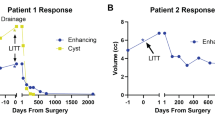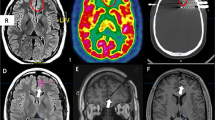Abstract
Background
Pediatric low-grade gliomas (LGGs) account for approximately half of all pediatric central nervous system tumors. The low-grade gliomas’ first line of treatment is gross total resection. However, when gross total resection is not possible, options for adjuvant therapy are limited. MRI-guided laser ablation (magnetic resonance-guided laser interstitial thermal therapy (MRgLITT)) offers a new option for treatment in selected cases. We present a description of the current MRgLITT technology and an exemplary case-series review of our experience in its use in LGGs.
Case description
A 19-month-old male was referred to the pediatric neurosurgery clinic with an incidental left temporal lesion discovered on a prenatal ultrasound. An MRI of the brain revealed a diffuse mesial temporal lesion. Electroencephalogram (EEG) showed generalized activity arising from the lesion. The patient underwent a navigation-guided biopsy then, two bolts were secured to the skull, and laser ablation was performed with intraoperative MR guidance. Pathology was consistent with ganglioglioma. Follow-up images 13 months after ablation showed a significant volumetric reduction in size of the tumor.
Discussion
It is important to achieve maximal resection of low-grade gliomas in children, lessening the need for adjuvant chemotherapy and radiotherapy, while minimizing the length of hospital stay and disruption to the child’s life. Of our nine LGGs patients treated with this technology, six had undergone previous surgery and MRgLITT proved itself to be a safe surgical treatment option to achieve further cytoreduction. While most of the cases are pilocytic astrocytomas, the location of the tumors was surgically challenging. Eight of the nine cases required a single trajectory—laser—while our case example requires two lasers. Only a case of a midbrain-thalamic tumor presented a post-ablation significant brain edema as perioperative complication [1]. Eight of the nine tumors did not require any coadjuvant therapy or further surgical treatment to date.
Conclusion
MRIgLITT is a successful option for treatment for selected de novo or recurrent low-grade gliomas in children. It can be combined with other therapies offering the advantages of a minimally invasive procedure. LITT may be added to the current pediatric neuro-oncology protocols, but larger prospective series are needed to show the effectiveness of LITT and to standardize indications and protocols.







Similar content being viewed by others
References
Tovar-Spinoza Z and Choi H (2016) Magnetic resonance-guided laser interstitial thermal therapy: report of a series of pediatric brain tumors. J Neurosurg Pediatr 17(6):723–33
Kleinhues PDNLW, OD, Burger P, Scheithauer B (2007) WHO grading of tumors of the central nervous system. WHO classification of tumors of the central nervous system, ed. DNO Louis, H Wiestler OD, Caene WK. Lyon, France: International Agency for Research on Cancer
Ostrom QT et al (2014) CBTRUS statistical report: primary brain and central nervous system tumors diagnosed in the United States in 2007-2011. Neuro Oncol 16 Suppl 4:iv1–63
Kahn T et al (1994) MRI-guided laser-induced interstitial thermotherapy of cerebral neoplasms. J Comput Assist Tomogr 18(4):519–32
Voigt J, Torchia M (2014) Laser interstitial thermal therapy with and without MRI guidance for treatment of brain neoplasms. A systematic review of the literature. Photonics Lasers Med 3(2):77–93
Norred S, Johnson AJ (2014) Magnetic resonance-guided laser induced thermal therapy for glioblastoma multiforme: a review., BioMed Research International
Jethwa P et al (2012) Magnetic resonance thermometry-guided laser-induced thermal therapy for intracranial neoplasms: initial experience. Neurosurgery 71(1):133–145
Carpentier A et al (2008) Real-time magnetic resonance-guided laser thermal therapy for focal metastatic brain tumors. Neurosurgery 63(1 Suppl 1):ONS21–8, discussion ONS28-9
Carpentier A et al (2011) Laser thermal therapy: real-time MRI-guided and computer-controlled procedures for metastatic brain tumors. Lasers Surg Med 43(10):943–50
Carpentier A et al (2012) MR-guided laser-induced thermal therapy (LITT) for recurrent glioblastomas. Lasers Surg Med 44(5):361–8
Leuthardt EC et al (2016) Hyperthermic laser ablation of recurrent glioblastoma leads to temporary disruption of the peritumoral blood brain barrier. PLoS One 11(2):e0148613
Patel NV et al (2015) Does the real-time thermal damage estimate allow for estimation of tumor control after MRI-guided laser-induced thermal therapy? Initial experience with recurrent intracranial ependymomas. J Neurosurg Pediatr 15(4):363–71
Missios S, Bekelis K, Barnett GH (2015) Renaissance of laser interstitial thermal ablation. Neurosurg Focus 38(3):E13
Medvid R et al (2015) Current applications of MRI-guided laser interstitial thermal therapy in the treatment of brain neoplasms and epilepsy: a radiologic and neurosurgical overview. AJNR Am J Neuroradiol 36(11):1998–2006
Jethwa PR et al (2011) Treatment of a supratentorial primitive neuroectodermal tumor using magnetic resonance-guided laser-induced thermal therapy. J Neurosurg Pediatr 8(5):468–75
Riordan M, Tovar-Spinoza Z (2014) Laser indiced thermal therapy (LITT) for pediatric brain tumors: case based review. Transl Pediatr 3(3):229–235
Choi H, Tovar-Spinoza S (2014) MRI-guided laser interstitial thermal therapy of intracranial tumors and epilepsy: state-of-the-art review and a case study from pediatrics. Photon Lasers Med 3(2):107–115
Tovar-Spinoza Z et al (2013) The use of MRI-guided laser-induced thermal ablation for epilepsy. Childs Nerv Syst 29(11):2089–94
von Tempelhoff W, Ulrich F (2014) Laser interstitial thermal therapy (LITT) of the brain. Photon Lasers Med 3(2):67–69
Izzo F (2003) Other thermal ablation techniques: microwave and interstitial laser ablation of liver tumors. Ann Surg Oncol 10(5):491–7
Germer C et al (1998) Technology for in situ ablation by laparoscopic and image-guided interstitial laser hyperthermia. Semin Laparosc Surg 5(3):195–203
Willie JT et al (2014) Real-time magnetic resonance-guided stereotactic laser amygdalohippocampotomy for mesial temporal lobe epilepsy. Neurosurgery 74(6):569–84, discussion 584-5
Larson T, Bostwick D, Corica A (1996) Temperature-correlated histopathological changes following microwave thermoablation of obstructive tissue in patients with benign prostatic hyperplasia. Urology 47:463–69
Goldberg S, Gazelle G, Mueller P (2000) Thermal ablation therapy for focal malignancy: a unified approach to underlying principles, techniques, and diagnostic imaging guidance. AJR Am J Roentgenol 174:323–31
Yaroslavsky AN et al (2002) Optical properties of selected native and coagulated human brain tissues in vitro in the visible and near infrared spectral range. Phys Med Biol 47(12):2059–73
McNichols R et al (2004) MR thermometry based feedback control of laser interstitial thermal therapy at 980 nm. Lasers Surg Med 34:48–55
Rieke V, Butts Pauly K (2008) MR thermometry. J Magn Reson Imaging 27:376–90
Schwabe B et al (1997) Laser-induced thermal lesions in the human brain: short- and long-term appearance on MRI. J Comput Assist Tomogr 21:818–825
Schwarzmaier HJ et al (1998) Treatment planning for MRI-guided laser-induced interstitial thermotherapy of brain tumors—the role of blood perfusion. J Magn Reson Imaging 8(1):121–7
De Poorter J et al (1995) Noninvasive MRI thermometry with the proton resonance frequency (PRF) method: in vivo results in human muscle. Magn Reson Med 33:74–81
De Poorter JM (1995) Noninvasive MRI thermometry with the proton resonance frequency method: study of susceptibility effects. J Magn Reson Med 34:359–67
Quesson B, de Zwart J, Moonen C (2000) Magnetic resonance temperature imaging for guidance of thermotherapy. J MagnReson Imaging 12:525–33
Welch A et al (1995) Definitions and overview of tissue optics. In: Press P (ed) Optical-thermal response of laser-irradiated tissue. P. Press, New York, pp 15–46
van Gemert M, Welch A (1995) Optical-thermal response of laser-irradiated tissue. Springer, New York
Mohammadi A, Schroeder J (2014) Laser interstitial thermal therapy in treatment of brain tumors—the NeuroBlate System. Expert Rev Med Devices 11:109–112
Louis DNO, Wiestler OD, Cavenee WK (2016) World Health Organization histological classification of tumors of the central nervous system. International Agency for Research on Cancer, France
Hawasli AH et al (2013) Magnetic resonance imaging-guided focused laser interstitial thermal therapy for intracranial lesions: single-institution series. Neurosurgery 73(6):1007–17
Eksi MS et al (2015) Gamma knife treatment of low-grade gliomas in children. Childs Nerv Syst 31(11):2015–23
Louis DN et al (2016) The 2016 World Health Organization classification of tumors of the central nervous system: a summary. Acta Neuropathol 131(6):803–20
Donahue B (1992) Short- and long-term complications of radiation therapy for pediatric brain tumors. Pediatr Neurosurg 18(4):207–17
Beebe DW et al (2005) Cognitive and adaptive outcome in low-grade pediatric cerebellar astrocytomas: evidence of diminished cognitive and adaptive functioning in National Collaborative Research Studies (CCG 9891/POG 9130). J Clin Oncol 23(22):5198–204
Qaddoumi I, Sultan I, Broniscer A (2009) Pediatric low-grade gliomas and the need for new options for therapy: why and how? Cancer Biol Ther 8(1):4–10
Fouladi M et al (2003) Survival and functional outcome of children with hypothalamic/chiasmatic tumors. Cancer 97(4):1084–92
Rees G et al (2004) Psychiatric outcome following paediatric intensive care unit (PICU) admission: a cohort study. Intensive Care Med 30(8):1607–14
Rennick JE (2015) Advancing our understanding of the psychological impact of PICU hospitalization: is it time to pause and reflect? Pediatr Crit Care Med 16(4):387–8
Rennick JE, Rashotte J (2009) Psychological outcomes in children following pediatric intensive care unit hospitalization: a systematic review of the research. J Child Health Care 13(2):128–49
Curry D et al (2012) MR-guided stereotactic laser ablation of epileptogenic foci in children. Epilepsy Behav 24(4):408–414
Author information
Authors and Affiliations
Corresponding author
Ethics declarations
Conflict of interest
Dr. Tovar-Spinoza is a consultant for Monteris Medical Inc.
Rights and permissions
About this article
Cite this article
Tovar-Spinoza, Z., Choi, H. MRI-guided laser interstitial thermal therapy for the treatment of low-grade gliomas in children: a case-series review, description of the current technologies and perspectives. Childs Nerv Syst 32, 1947–1956 (2016). https://doi.org/10.1007/s00381-016-3193-0
Received:
Accepted:
Published:
Issue Date:
DOI: https://doi.org/10.1007/s00381-016-3193-0




